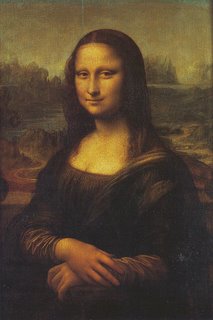Smile Mona, Smile

Of interest to fellow emotion scientists, a CNN.com article reports that facial emotion recognition software indicates the Mona Lisa is feeling mostly happy. There are many interesting models trying to recognize and interpret facial emotion, a clear communication function (for more on modeling, read this posting).
It is easy for us -- humans -- to see that the Mona Lisa is smiling, but it is much more tricky to get a computer to do the task. And it is much more difficult yet to get a computer to do it in real time with real faces, that change shape, direction, orientation, and expression amazingly quickly. The CNN.com article reports that the model predicted that the Mona Lisa was 83% happy and 9% disgusted. My guess is that is a misunderstanding by the journalist and that the 83% has more to do with the probability of the prediction -- or the confidence in the prediction -- rather than really intending to slice up the emotion pie in this fashion.
Having never examined the painting with my emotion theorist hat on, I immediately recognized that not only is she happy, but she is genuinely happy. In our lab, we measure facial EMG to index emotion. We can measure the electrical potentials in the muscle fibers that make us smile and frown. To express pleasant emotion, we use two prominent muscle groups that can be easily measured. First, we use the zygomaticus major muscle group, which draws up the corners of the mouth in a smile. However, we also use the orbicularis oculi muscle group, which turns up the corners of the eye.
The interesting point worth noting is that we can voluntarily control the zygomatic response, but the orbicularis group is not subject to conscious control. This means that when you fake a smile, you turn up the corners of the mouth but not the corners of the eye. So if you train yourself to look -- which admittedly I have not done -- you can be a bit of an amateur lie detector when it comes to smiling. And now that you have this training, you can see both muscle groups at work in the Mona Lisa.
I find this especially interesting since it indicates that Leonardo da Vinci was aware of that difference, for it would have been virtually impossible for any model to have held the real smile long enough to paint a portrait. Since da Vinci died in 1528, and the French neurologist Guillaume Duchenne who wrote extensively about the difference between real and genuine smiles was not born until 1806, this marks yet one more way in which da Vinci was a pioneer.
As a note of trivia, genuine smiles often are called Duchenne smiles for his extensive work in the area. As a second note of trivia, this is one of the many reasons why "method" acting is successful. An actress more convincingly smiles when she actually feels happy.




 FOLLOW SAM ON TWITTER
FOLLOW SAM ON TWITTER
 SUBSCRIBE TO THIS FEED
SUBSCRIBE TO THIS FEED

0 Comments:
Post a Comment
<< Home